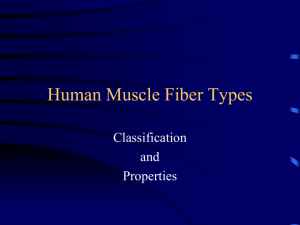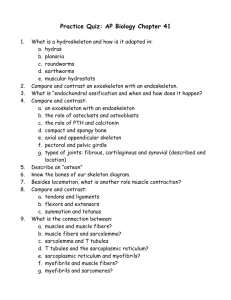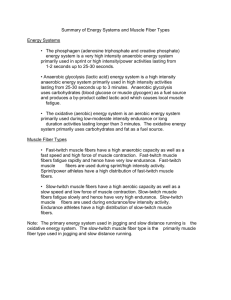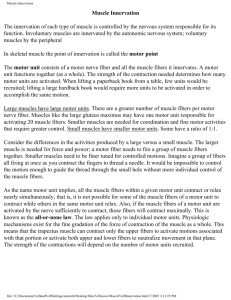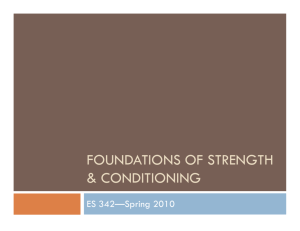Teaching Philosophy
advertisement
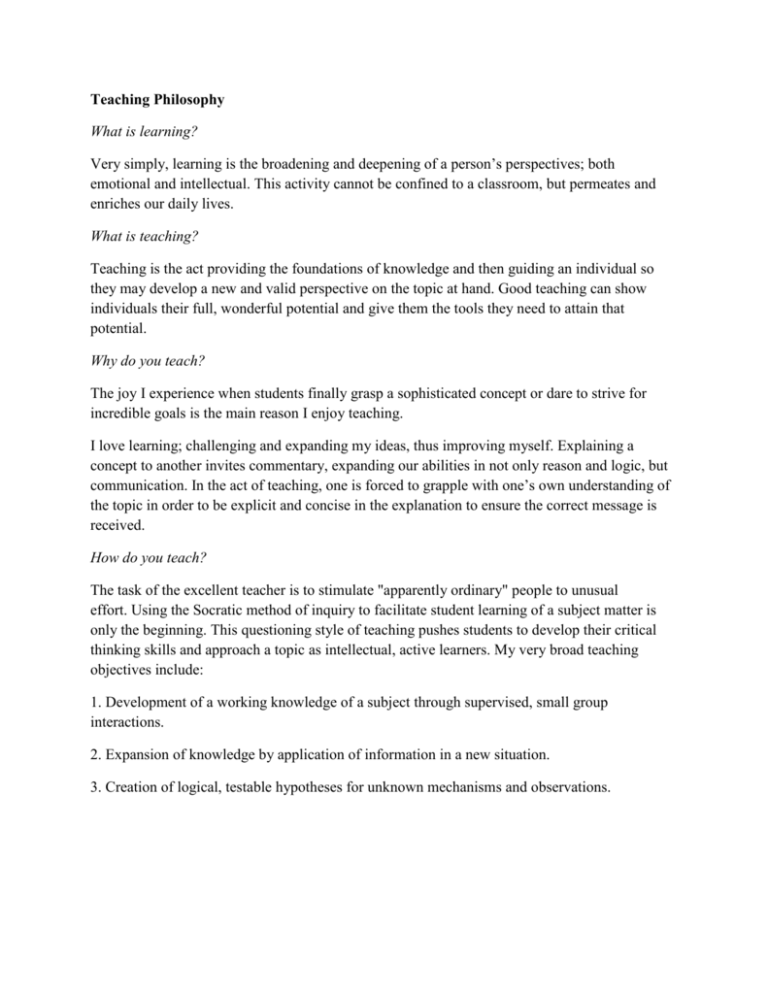
Teaching Philosophy What is learning? Very simply, learning is the broadening and deepening of a person’s perspectives; both emotional and intellectual. This activity cannot be confined to a classroom, but permeates and enriches our daily lives. What is teaching? Teaching is the act providing the foundations of knowledge and then guiding an individual so they may develop a new and valid perspective on the topic at hand. Good teaching can show individuals their full, wonderful potential and give them the tools they need to attain that potential. Why do you teach? The joy I experience when students finally grasp a sophisticated concept or dare to strive for incredible goals is the main reason I enjoy teaching. I love learning; challenging and expanding my ideas, thus improving myself. Explaining a concept to another invites commentary, expanding our abilities in not only reason and logic, but communication. In the act of teaching, one is forced to grapple with one’s own understanding of the topic in order to be explicit and concise in the explanation to ensure the correct message is received. How do you teach? The task of the excellent teacher is to stimulate "apparently ordinary" people to unusual effort. Using the Socratic method of inquiry to facilitate student learning of a subject matter is only the beginning. This questioning style of teaching pushes students to develop their critical thinking skills and approach a topic as intellectual, active learners. My very broad teaching objectives include: 1. Development of a working knowledge of a subject through supervised, small group interactions. 2. Expansion of knowledge by application of information in a new situation. 3. Creation of logical, testable hypotheses for unknown mechanisms and observations. I can provide an applicable and lasting physiology education. I can create an educational experience where ‘big picture’ concepts are constructed by weaving a patchwork of specific ideas and mechanisms. By fostering a relaxed yet exploratory atmosphere in my classroom, with questions asked and answered from both teacher and students, I can encourage my students’ thoughtfulness and desire to learn. My teaching methods are shaped primarily by student suggestions, so that together we can explore the principles and push the limits of their current understanding of the subject. Given a supportive atmosphere, and interactive and passionate instruction, I believe that any student can walk leave my classroom not only with a firm grasp of the subject matter, but with lessons that will serve them well, whatever their future endeavors. How do you measure your effectiveness? Student feedback that continuously serves as a system of checks and balances to ensure that I am engaging, informing, and encouraging students in a conducive and open learning environment is the foundation of my evolving teaching style. I incorporate both formal quantitative and qualitative measures of student evaluation into my class but also conduct informal polls frequently so I can be attuned with current student attitudes, successes, and frustrations to better adapt my teaching to suit any particular situation dynamic. What qualities describe an effective teacher? Imaginative An effective teacher is one who presents information in an invigorating manner, whether by using an interesting method of instruction or presenting a topic from refreshingly new perspective. Adaptable An effective teacher is one who can adjust to any situations that students present. While having a plan of action on any particular day is important, the ability to change according to the students’ learning needs is essential. Goal-Oriented An effective teacher is one who clearly outlines specific learning and course objectives. Providing a learning ‘roadmap’ allows students to understand both why they are learning the material and why the course is taught in a particular manner. Contextual An effective teacher is one who connects their subject matter to the students’ own frame of reference. Providing real-world applications to sometimes seemingly unrelated material is the easiest way to gain student interest and foster self-motivation. Persistent An effective teacher is one who maintains their learning objectives in the face of student frustration or fatigue. Placing the responsibility of learning back onto the students and gently encouraging critical thinking through intentioned questions will allow students to walk away confidently from a class with a dynamic understanding of the topic. Reflection on teaching students to be scientific skeptics. Skepticism leads to a deeper understanding of a topic by allowing students to delve deeper into concepts that are taught and to challenge then. It is the students’ responsibility to decide whether convention is correct or a topic should be approached from a different perspective (and thus make up their own. Basically using scientific literature to elaborate and give depth to lecture/lab concepts is essentially another way to debunk the prevalent current teaching approach that is a passive, spoon-fed style of shoveling trivial details onto students without kindly forcing them to step back, connect the dots, and analyze the whole, brilliant picture. Teaching current controversies through primary literature articles allows students to draw on their own knowledge and show them how much they do actually know (they rarely give themselves enough credit) and to give them the confidence to come to their own conclusions on a subject. To think independently, with both a linear and patchwork approach, can be the goal of students in higher education. Relevant Experiences I have six semesters as a graduate student teaching assistant for the required course, Physiology 335, for pre-health professional students. I am responsible for conducting weekly laboratory and discussion sessions. In addition I hold regular office hours for question and answer periods, assist in the grading of student work, and prepare course worksheets and handouts. While having taken a basic animal physiology course in my undergraduate work, I did not remember much when I began my adventures in teaching. And what an adventure it has proven to be! Teaching has been such a wonderful opportunity to understand myself and how I learn. Knowing this, allows me to not only empower myself, but my students. Through these past semesters, my students have become my teachers. I have had to acknowledge and overcome my weaknesses to gain patience and perspective and heighten my conscientiousness. Teaching has also taught me the meaning of humility and the courage to admit to and minimize personal shortcomings. Recognizing your humanity in another's eyes brings a strength and confidence to yourself. Artifact #1-Pre/Post Basic Physiology Knowledge Assessment Name:________________________________________ 1. The point at which an impulse is transmitted from one neuron to another neuron is called the: a) b) c) d) e) dendrite glial cell nerve center synapse terminal plate 2. Which of the following is a substance that aids the transmission of nerve impulses? a) b) c) d) e) acetylcholine cholecystokinin deoxyribose oxytocin dopamine 3. Where is the sinoatrial node located? a) b) c) d) e) between the left atrium and the left ventricle between the right atrium and the right ventricle in the interventricular septum in the upper wall of the left ventricle in the upper wall of the right atrium 4. Oxygenated blood is carried to the heart by the: a) b) c) d) e) aorta carotid arteries inferior vena cava pulmonary veins superior vena cava 5. In the lungs, gas exchange occurs in tiny one-celled air sacs called: a) b) c) d) e) alveoli bronchi bronchioles capillaries pleurae 6. Select the correct statement about O2 transport in the blood. During normal activity, a molecule of Hb returning to the lungs contains one molecule of oxygen: a) As pH decreases, oxygen's affinity for Hb increases b) A 50% oxygen saturation level of blood returning to the lungs might indicate a higher activity level than normal c) All of the above d) None of the above 7. Total lung capacity is equal to: a) b) c) d) Vital capacity x Tidal volume Functional residual capacity + Expiratory reserve volume Anatomical dead space + Alveolar dead space Residual volume + Vital capacity 8. The red blood cell count increases after an individual spends significant time at higher altitude because: a) b) c) d) e) temperature is lower at higher altitudes basal metabolic rate is lower at higher altitudes basal metabolic rate is higher at higher altitudes atmospheric Po2 is higher at higher altitudes atmospheric Po2 is lower at higher altitudes 9. Which of the following might trigger erythropoiesis? a) b) c) d) increased tissue demand for O2 decreased tissue demand for O2 an increased number of neutrophils decreased concentration of blood lactate levels 10. Which of the following is the lymphoid organ that is a reservoir for red blood cells and filters organisms from the blood? a) b) c) d) e) appendix gallbladder pancreas spleen thymus 11. Which of the following cell types is responsible for synthesizing the organic component of bone matrix? a) b) c) d) e) chondrocytes osteoblasts osteocytes chondroclasts more than one of the above 12. In a bone that experienced a marked decline in mechanical stress, the amount of new bone matrix deposited would: a) increase b) decrease c) no change 13. Which of the following hormones acts to stimulate osteoclast activity and thus increase bone resorption? a) b) c) d) e) growth hormone parathyroid hormone calcitonin insulin creatinine 14. An overlap of actin and myosin filaments occurs in the: a) b) c) d) e) A Band I Band Z Line H Band M Line 15. Motor units: a) b) c) d) e) are found only in cardiac muscle are largest in muscles responsible for delicate movements consist of a muscle fiber and all the nerves that supply it consist of a motor neuron and all the muscle fibers it supplies are the same as neuromuscular junctions 16. In muscle tissue, neurotransmitter receptors are located: a) b) c) d) in synaptic vesicles on the motor neuron axon terminals in the synaptic cleft on the motor end plate 17. This process aids in skeletal muscle relaxation after contraction: a) b) c) d) e) Ca2+ is released from intracellular storage sites motor neurons send electrical signals to muscle fibers acetylcholinesterase synthesizes acetylcholine troponin binds Ca2+ none of the above 18. Aerobic exercise will have this effect on skeletal muscle tissue: a) b) c) d) e) increased # of mitochondria per muscle cell increased # of muscle fibers increased # of motor units decreased # of skeletal muscle fibers none of the above 19. During ventricular systole: a) b) c) d) e) the atria are contracting the AV valves are closed the intraventricular pressure is less than the intraatrial pressure the mitral valve is open blood is forced into the ligamentum arteriosum 20. As blood travels from the aorta to the capillaries: a) b) c) d) e) pressure increases viscosity increases resistance increases velocity increases flow increases 21. When glucose is catabolised in the absence of oxygen: a) b) pyruvate formed in glycolysis will generally be converted to lactate. pyruvate formed in glycolysis will generally be converted to acetyl coenzyme A, which will enter the Krebs cycle. c) the number of ATP moles formed per mole of glucose will be less than the number formed in the presence of oxygen. d) A and C. e) B and C. 22. The oxidative production of ATP involves: a) b) c) d) e) f) Glycolysis Lactic Acid NADH Glycogen Electron Transport Chain B and D 23. Which of the following is not true regarding the comparison of type I (slow oxidative) and type II b (fast-glycolytic) skeletal-muscle fibers: a) b) c) d) e) Type I fibers have more abundant mitochondria. Type I fibers fatigue more readily. Type I fibers have more abundant myoglobin. Type I fibers have more abundant capillaries. Type I motor units contain fewer fibers than type IIb motor units. 24. _________ intensity exercise affects __________fibers, ____________the number of mitochondria and capillaries. a) b) c) d) low intensity, glycolytic, increasing. high intensity, oxidative, decreasing. high intensity, glycolytic, increasing. low intensity, oxidative, increasing. 25. _________ intensity exercise affects __________fibers, ____________ their diameter through synthesis of actin and myosin filaments. a) b) c) d) low intensity, glycolytic, increasing. high intensity, oxidative, decreasing. high intensity, glycolytic, increasing. low intensity, oxidative, increasing. Artifact #2-Student Perceptions Survey and C.R.E.A.T.E. outline Name: ____________________________________ (Same as breed used in Physiology assessment) Please respond to each statement on a 1-10 scale with a 1 indicating “strongly disagree” and 10 indicating “strongly agree.” Please take the time to reflect on and answer the questions that may follow some statements. Scientific literature explorations in the classroom are worthwhile as a learning tool. _____ Why or why not? Scientific literature explorations are an effective way for me to learn topics in the classroom._____ If so, why? If not, by what method do you prefer to gather information and learn? I am intimidated by reading primary scientific literature._____ What intimidates you about primary literature articles? Please rank each of the following. _____Statistics _____Graphs/Figures _____Vastness/Scope of topic _____Terminology/Jargon _____Confusion as to the ‘mission of research’ in general. _____Difficulty in seeing the ‘forest through the trees’ and relating minutia back to the ‘big picture’ and real life. Consider how you would begin reading/evaluating a paper. Do you have a formulaic approach? (yes/no) If so, when did you first learn this method of analyzing articles? Do you read the abstract and discussion and then decide if you will read the entire piece? Do you evaluate figures/graphs rather than reading the body of the paper? Or do you simply skim? I feel confident in my ability to read and interpret primary literature articles._____ I feel confident in my ability to analyze/critique primary literature articles._____ I feel confident in my ability to read a primary literature article and think of a logical, follow-up experiment._____. Why did you rank yourself accordingly in the above statements? C.R.E.A.T.E. Approach to Primary Literature Consider Sum up introduction in a sentence or concept map Define relevant variables/concepts Determine their relationships Read Define unknown terms/words Sum up figures in a sentence or concept map Create cartoons/sketches of complex models/ideas Elucidate Hypothesis For each figure, define the hypothesis being tested or question addressed Rewrite the title of each figure in your own words Analyze and Interpret Data Using all your findings from the previous steps, track the logic of each experiment. Prepare a concept map for the paper using each illustration as a point of reference to reveal the logic of the study design. Think of the next Experiment Consider a follow-up experiment to test any questions that were raised during the discussion of the paper. What is your hypothesis and how would you design those subsequent experiments? The C.R.E.A.T.E. approach to primary literature was created by Sally G. Hoskins, David Lopatto, and Leslie M. Stevens and was published in CBE-Life Sciences Education Vol. 10, 368-378, Winter 2011.



